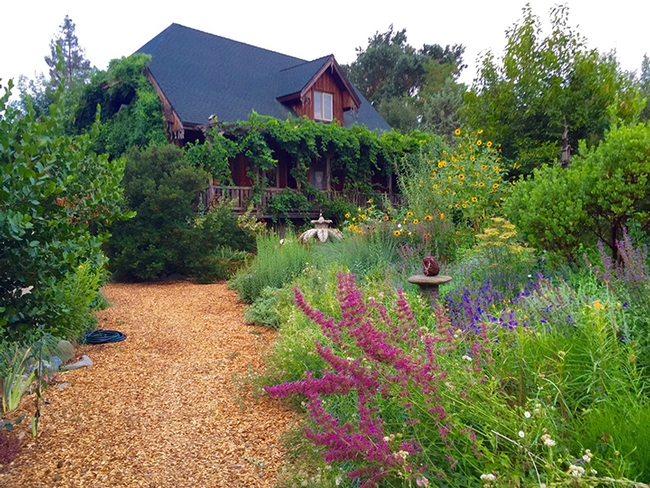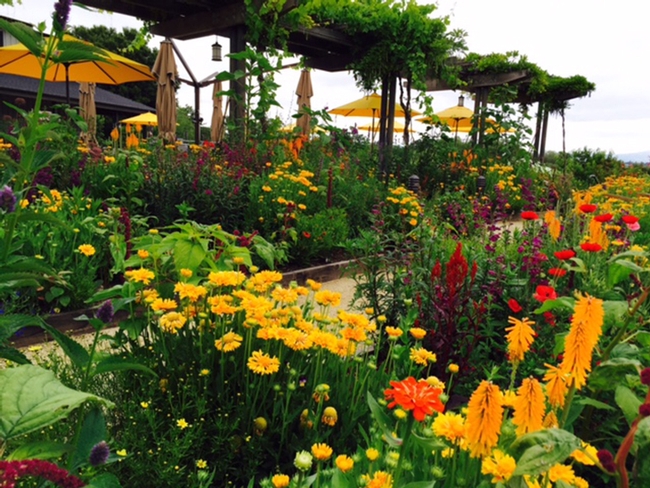- Author: Kathy Keatley Garvey
It's Thanksgiving Day and time to give thanks for NOT what we WANT, but what we HAVE.
And, not for what we OWN, but what we CANNOT.
That includes the yellow-faced bumble bee, Bombus vosnesenskii.
On the morning of Nov. 12, we traveled to the Sonoma Cornerstone, Sonoma, to check the plants and pollinators in Kate Frey's amazing pollinator garden. Kate Frey, co-author of The Bee-Friendly Garden" (with UC San Francisco professor Gretchen LeBuhn), is a world-class garden designer and pollinator advocate.
Flashback to Sept. 23, the last time we visited the Frey garden. We noticed monarch butterflies, painted ladies, honey bees and--one bumble bee, a hungry queen Bombus vosnesenskii, newly emerged from winter hibernation to grab something to eat. Sometimes on warm sunny days, the queens will disrupt their hibernation to search for nectar. They. Are. Hungry.
At 12:30 on Nov. 12, the temperature rose to 62 degrees.
And then we saw her, The Queen. The Queen. Resplendent in gold and black, she buzzed loudly toward the spiked floral purple plant, Salvia indigo spires (Salvia farinacea x S. farinacea). Honey bees quickly moved out of her way as she claimed the nectar, all of it. Her wings glowed in the sunlight and her buzz seemed loud enough to break the sound barrier.
Is there anything more bee-utiful?
One bumble bee. One queen. A royal moment.
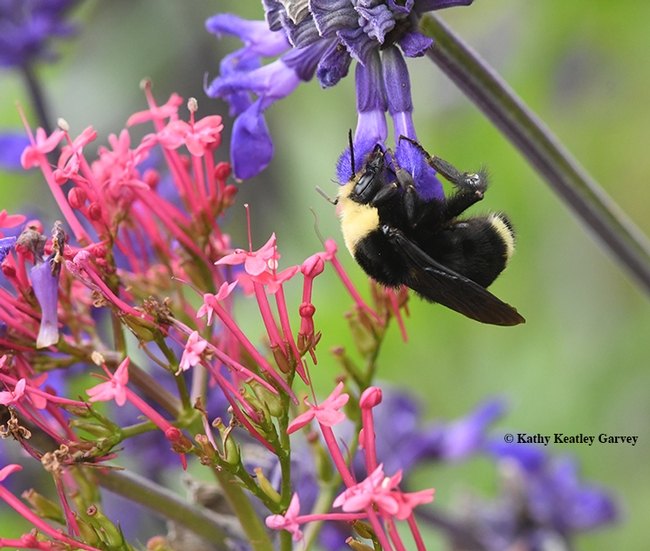
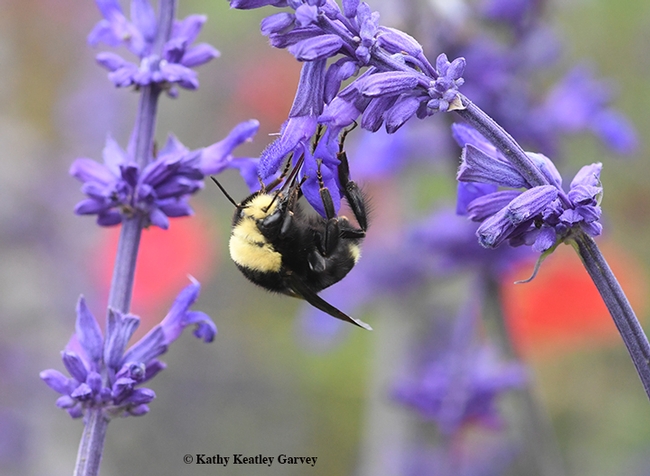
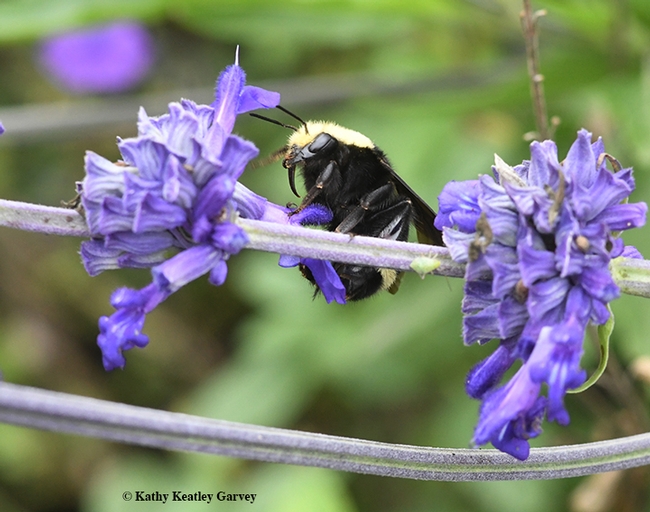
- Author: Kathy Keatley Garvey
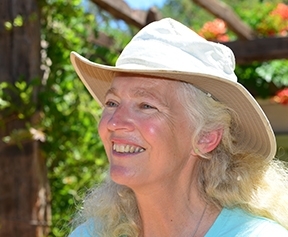
That's a question we're often asked and now we have an answer: Saturday, Oct. 7.
World-class bee garden designer and pollinator advocate Kate Frey, co-author of The Bee-Friendly Garden" (with UC San Francisco professor Gretchen LeBuhn), is inviting folks to join her to "see the principles and practices of the American Garden School expressed and demonstrated" in her unique pollinator garden in Hopland, inland Mendocino County.
A workshop from 9:30 a.m. to 10:30 a.m. will cover design, site preparation, building health soil, weed control, bees and wildlife in the garden, plant care, and will look at some recommended plant varieties. It will end with an irrigation system demonstration. The cost is $35 for the workshop.
If you want to attend the garden tour, it's from 10:30 a.m. to 2 p.m. The cost is $10, and participants are invited to bring their lunch.
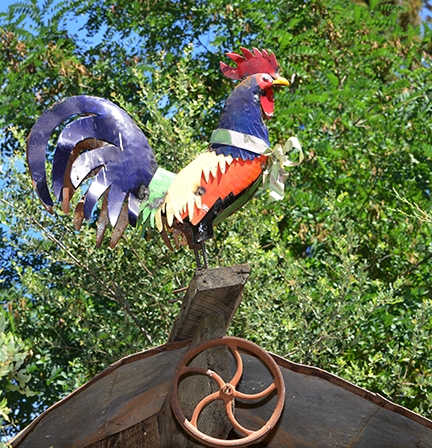
Worldwide, there are 20,000 species of bees. Of that number, 4000 are found in the United States, and 1600 of them in California. A good many of them are found in the UC Berkeley Urban Gardens (see UC Berkeley Urban Bee Lab and in the Frey garden!
The Frey gardens include floral borders, a vegetable garden, unique rustic structures and whimsical art (the work and/or collection of husband Ben), a chicken palace and more. With the Swiss chalet home, this is straight out of a storybook! Indeed, visitors call it an "instant sanctuary," says Kate. They marvel at the beauty, the color, and the paths just begging to be explored. A feast for the eyes; serenity for the soul.
You can register on the American Garden School site. Directions are posted online.
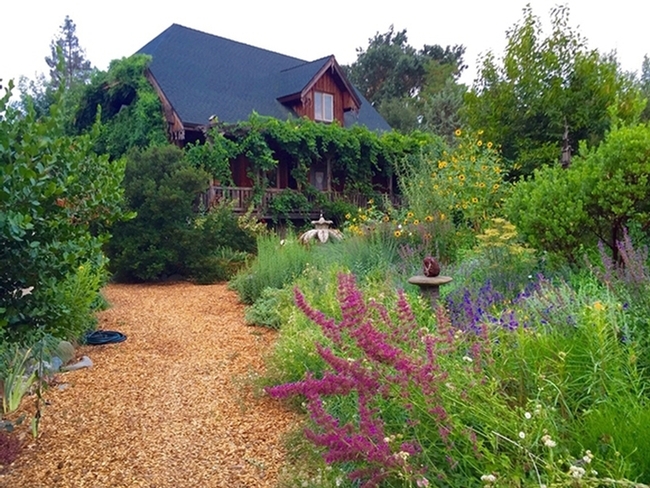
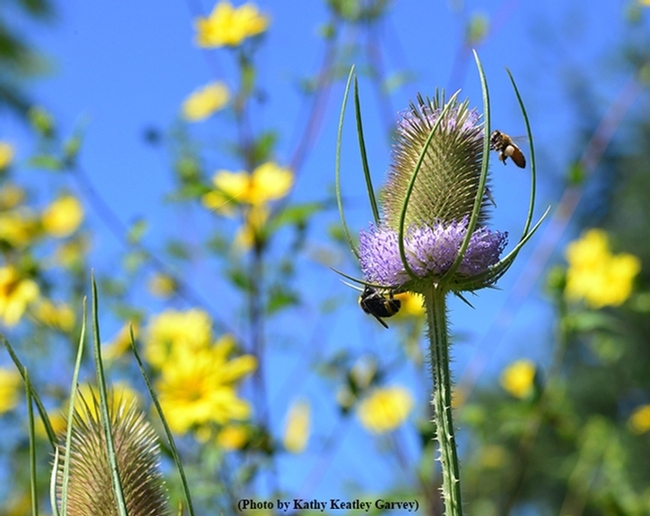
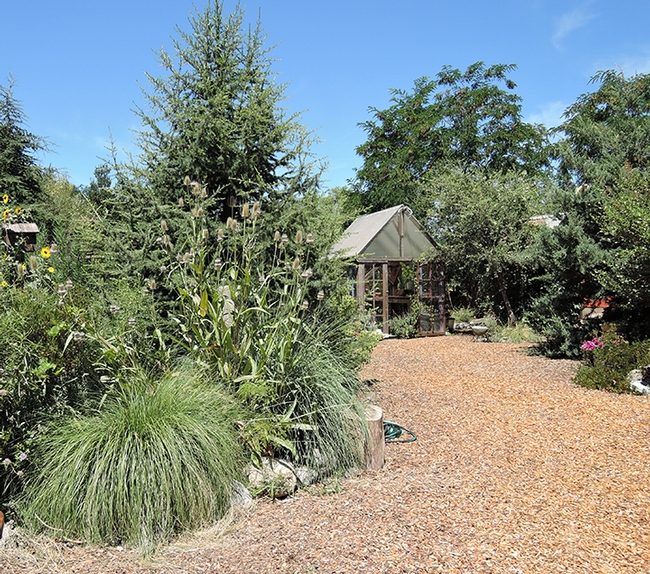
- Author: Kathy Keatley Garvey
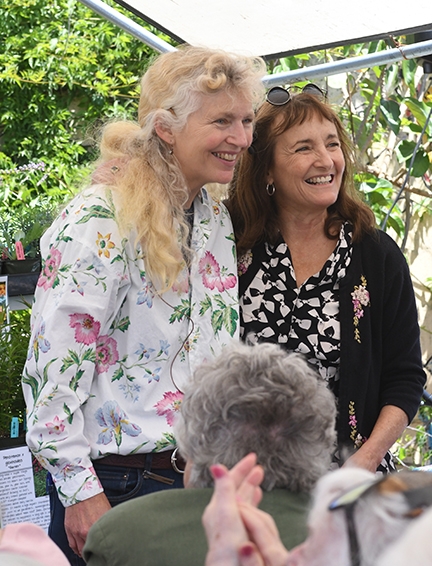
“I'd love to attract honey bees, bumble bees and other pollinators, but what can I do?" you ask. "Where do I start?"
So we asked world-class garden designer Kate Frey of Hopland, a two-time gold medal winner at the prestigious Chelsea Flower Show in London, co-founder of the American Garden School, and co-author of The Bee-Friendly Garden (with Professor Gretchen LeBuhn of San Francisco State University) for her advice.
Few people are as passionate about pollinators and pollinator gardens as Kate Frey.
We heard her speak at the Native Bees Workshop last September at the Hopland Research and Extension Center, Mendocino County, and we tagged along on her guided tour of her one-acre spectacular garden at her Hopland home, where she and husband Ben and assorted pets reside. We also heard her speak on "Gardening for Bees, Beauty and Diversity" May 14 at Annie's Annuals and Perennials, Richmond.
Kate is highly sought as a speaker, whether it be at sustainable landscape programs, gardening seminars, or at UC workshops. Among her affiliates: University of California entomologists Robbin Thorp, distinguished emeritus professor at UC Davis, and Professor Gordon Frankie of UC Berkeley. (Read what Frankie has to say about native bees.)
So, what to do first? Kate offers these tips:
- Create healthy gardens that require no pesticides by using the right plant, right place approach, add quality compost to all plants and irrigate adequately.
- Choose appropriate plants for your water, soils, exposure, climate, and if annuals, season!
- Think in terms of abundance, not minimalism. Plant at least a 3-x-3 foot area of each plant, or repeat the same plant throughout your garden. Each honey bee colony needs an estimated one-acre of flowers to support it.
- Goal: 12 months of bloom. Plants can be annuals, perennials, shrubs or trees.
- Make sure plants do offer floral resources, as many landscape plants don't.
- Have patches or repeated plants of the same flower. Honey bees practice floral constancy.
- Include water for honey bees
- Sunny spaces are the best.
- Provide bee-block nests and mulch-free nest sites for native bees.
All great advice! Indeed, we should think of pollinators as not mere "visitors," but permanent residents. Plant what they like and they will come. To ensure that they will stay stay, leave soil bare for ground-nesting bees, such as bumble bees. And don't forget those bee-block nests, or bee condos, for leafcutter bees and blue orchard bees.
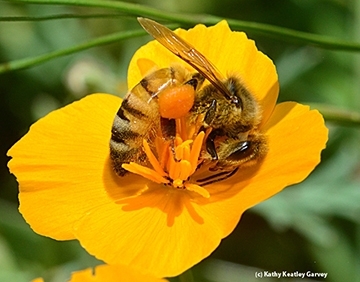
- Asclepias milkweeds, all
- Asters, Aster x frikartii 'Monch' A. ericoides ‘Monte Casino', A. laterifolius Lady in Black'
- Agastache, ‘Black Adder' ‘'Purple Haze' Rosy Giant' ‘Tutti Frutti' and many more
- Arbutus unedo, Strawberry tree
- Arctostaphylos, most Manzanita
- Calamentha nepetoides, Calamentha
- Ceanothus, all California lilac
- Epilobium, California fuchsia. There are many good cultivars
- Eriogonum fasciculatum, California buckwheat
- Gaillardia, Blanket flower
- Helianthus bolanderi, native shrubby sunflower
- Monardella villosa, Coyote mint
- Nepeta faassenii, all nepetas, Catmint
- Origanum, flowering oregano, all. Origanum 'Santa Cruz' and 'Bristol Cross' are good.
"Bee gardens make people happy," Kate Frey and Gretchen LeBuhn write in their book. "Whether you enjoy a brilliant chorus of saturated color, a tranquil sanctuary from the busy world, or a hardworking edible garden, there is a glorious, flower-filled bee garden waiting for you."
Yes, we all need a happy place. And so, too, do the pollinators.
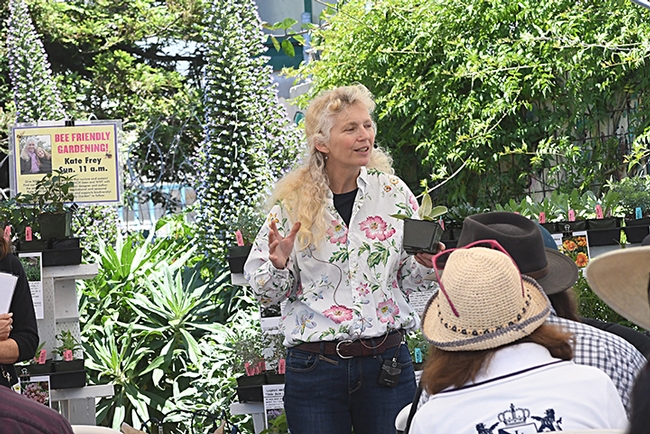
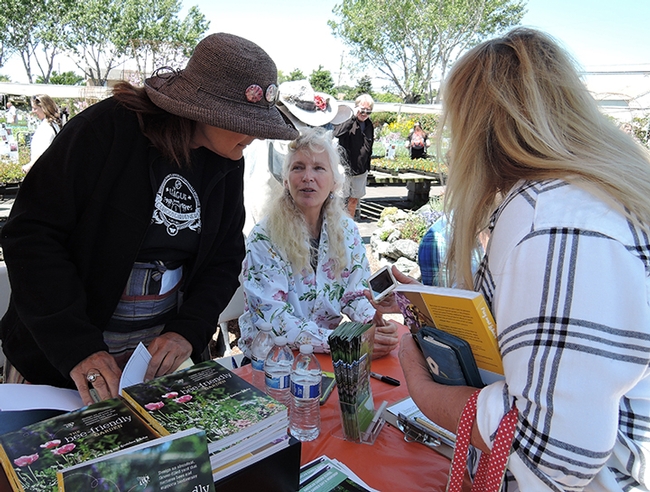
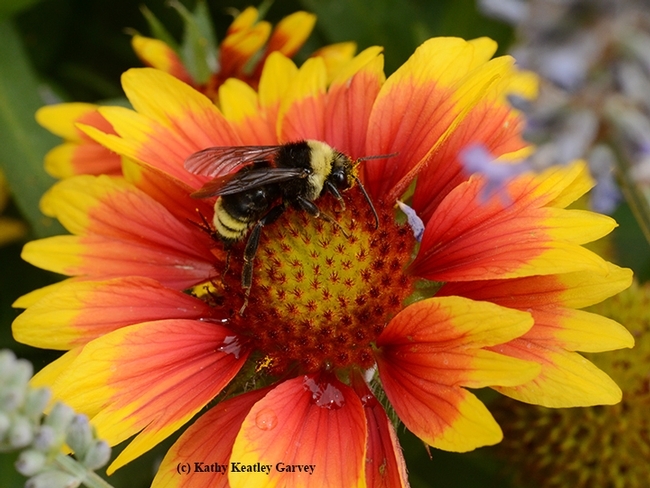
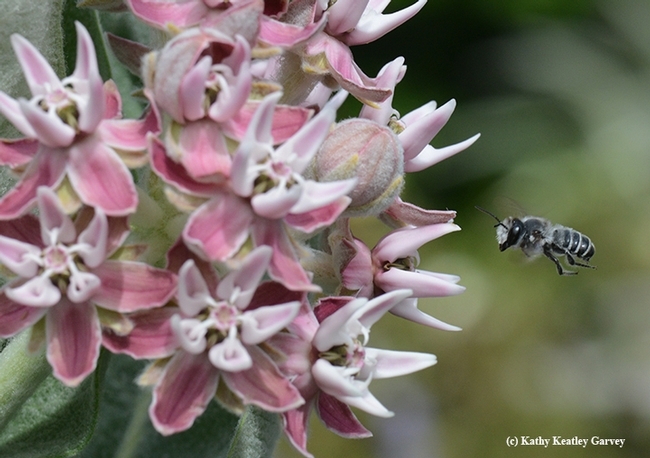
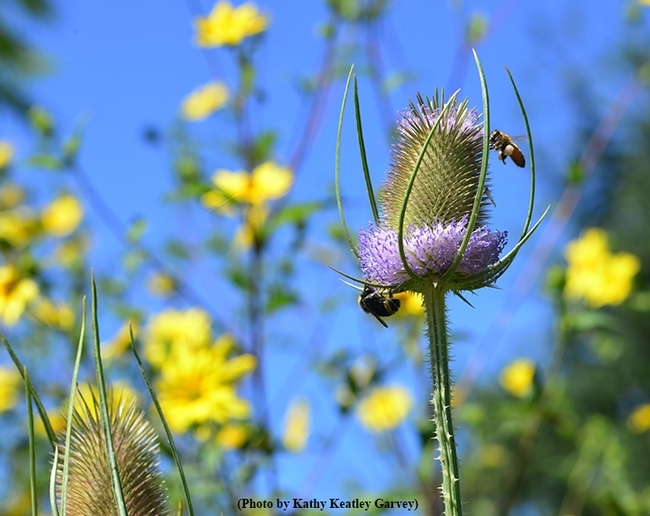

- Author: Kathy Keatley Garvey
We just met a male black-faced bumble bee, Bombus californicus.
It was early morning and he was resting on a blanket flower (Gaillardia), a brilliant member of the sunflower family. When you're a bee, a blanket flower offers both bed and breakfast.
Gaillardia was named after M. Gaillard de Charentonneau, an 18th-century French magistrate who was a patron of botany, according to Wikipedia. "The common name may refer to the resemblance of the inflorescence to the brightly patterned blankets made by Native Americans."
The bumble bee species, a native, takes its name from California. Unlike the yellow-faced bumble bee, Bombus vosnesenskii, its face is black and long. (Except when it's covered with golden pollen.)
Authors Kate Frey and Gretchen LeBuhn in their newly published book, The Bee Friendly Garden, note that unlike honey bees, bumble bees can fly in "cold rainy weather...They have several physiological adaptations that allow them to fly in bad weather, including the ability to shiver to raise their body temperature."
Frey, a world-class garden designer and LeBuhn, a bee expert and professor at San Francisco State University, offer advice on how to attract bumble bees and other pollinators to your garden. They quote native pollinator specialist Robbin Thorp, distinguished emeritus professor of entomology at the University of California, Davis, and the co-author of Bumble Bees of North America: And Identification Guide and California Bees and Blooms: A Guide for Gardeners.
What we know is this: it's good to have bed and breakfast for a bumble bee. Much of the bumble bee population is declining and we all need to do what we can to protect them and provide for them.

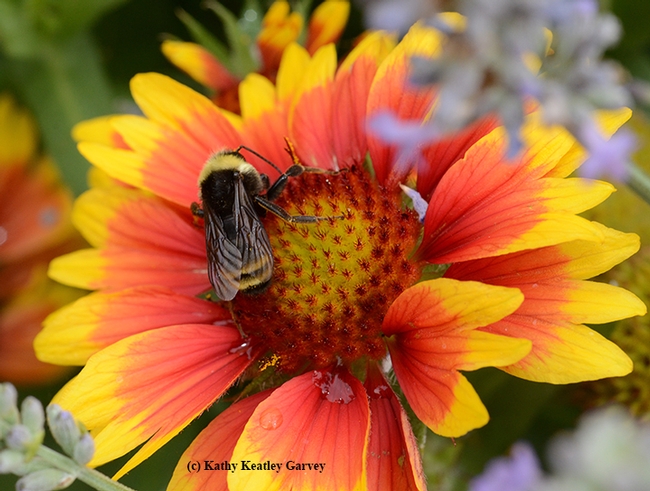
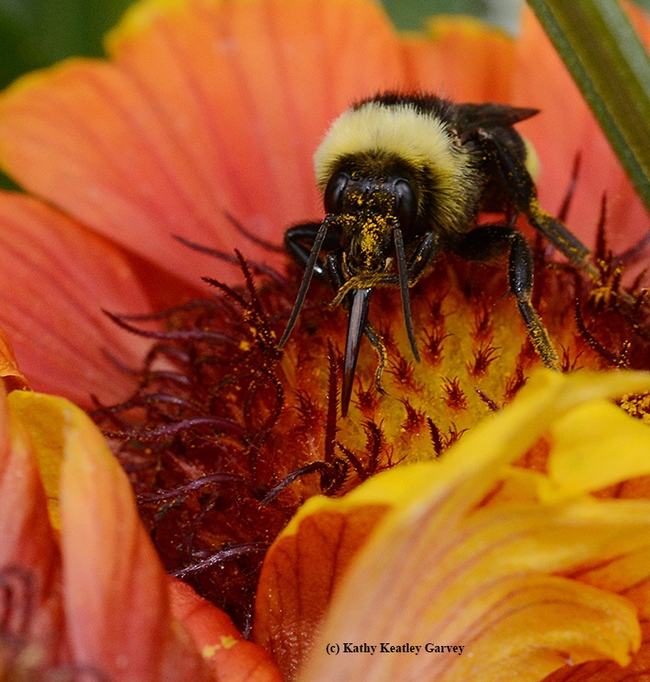
- Author: Kathy Keatley Garvey

That's how we felt when we recently visited the one-acre pollinator bee garden of Kate Frey and her artist husband, Ben, in Hopland, Mendocino County. It's magical.
Kate, a world-class garden designer, and bee expert Gretchen LeBuhn, professor in the San Francisco State University, have just co-authored The Bee-Friendly Garden, an educational, enthusiastic and inspiring book that will help you turn your own garden--large or small, rural or urban--into something magical.
Among her many honors, Kate Frey twice won gold medals at the prestigious Chelsea Flower Show in London and received a Silver Gilt award in 2003. She met Queen Elizabeth, who admired her work. Currently Kate directed and taught at Sonoma State University's Sustainable Landscape Program with Extended Education, and consults for various wineries and residences around California, including The Melissa Garden in Healdsburg (privately owned and now closed) and Lynmar Estate Winery in Sebastopol. Her website, http://freygardens.com, offers more information about her and her mission. It's all about the pollinators and how to attract them!
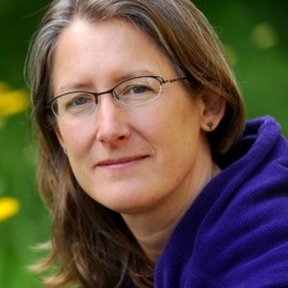
The Frey/LeBuhn team says it well in the preface: “Bee gardens make people happy. Whether you enjoy a brilliant chorus of saturated color, a tranquil sanctuary from the busy world, or a hardworking edible garden, there is a glorious, flower-filled bee garden waiting for you.”

They cover:
- The Benefits of a Bee Friendly Garden
- Our Friends, the Bees
- Plants for Your Bee Friendly Garden
- Bee Friendly Plants for Edible Gardens
- Bee Garden Basics
- Designing Your Bee Garden
- Beyond Your Own Backyard: Becoming a Bee Activist
Their book also contains resources, and regional plant lists for the Southeast, South Central, Southwest, and Pacific Northwest regions, Rocky Mountain/Intermountain West Region and the Northeast/Midwest/Mid-Atlantic Region.

The Frey/LeBuhn team recommends that you “keep a notebook throughout the year and write down the names of plants and which bees are visiting them. This is a fun and informative exercise wherever you go—from your home, to visiting friends, to walks around the neighborhood or anywhere you go in the world,” they write. “Much information can be gleaned this way, much discovered and much shared. Everyone can be a local expert.”
We love the photos of pollinators and gardens in the book—many taken in the Frey garden and in the Melissa Garden. They also focus on small-scale gardening—you don't need a huge space for a bee garden. (The urban Garvey garden is an example!)
Laurie Davies-Adams, executive director of the Pollinator Partnership, says that “this book will make bees happy and healthy in gardens across the country.”
Yes, and people, too!
(Note: The Frey garden will be open June 18 for the Garden Conservancy Open Days Program. See https://www.gardenconservancy.org/open-days/garden-directory/frey-gardens. Here is the entire schedule: https://www.gardenconservancy.org/events/all-events/mendocino-county-ca-open-day-3)

